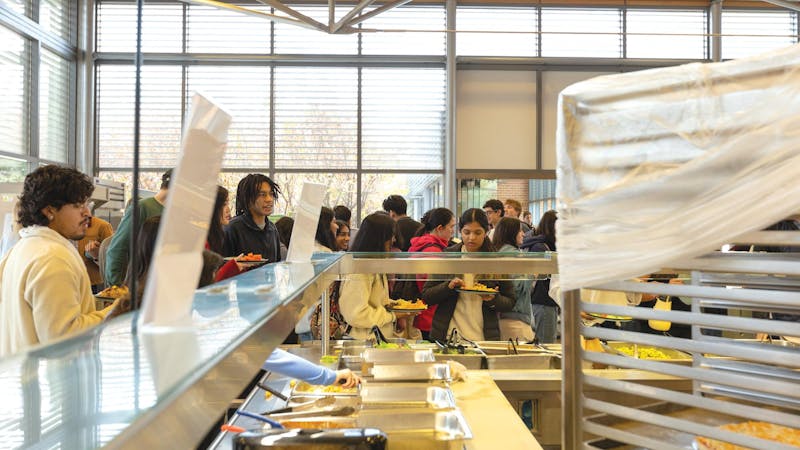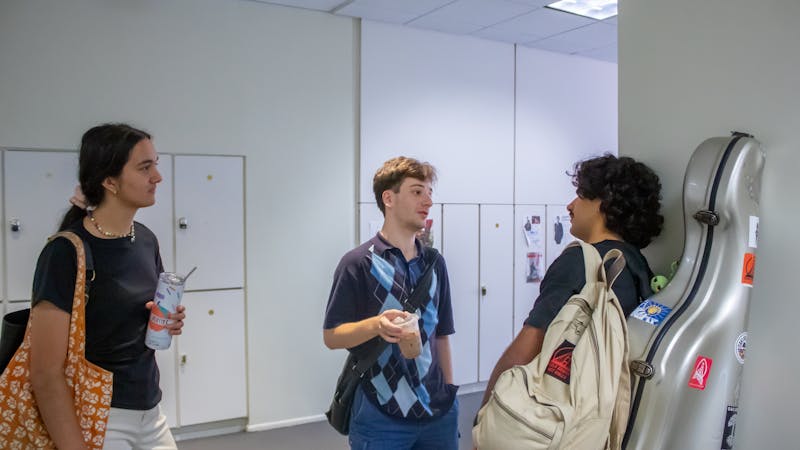The Zoom Experiment: Faculty share mishaps, adaptations and creative solutions

More than two weeks ago, faculty and students embarked on a remote-learning journey, most of them using a combination of Zoom’s videoconferencing platform and Rice’s Canvas platform. While faculty have experienced mishaps surrounding internet stability and lagging, many have embraced the platform and found creative avenues for continuing their classes.
Laura Kabiri, a kinesiology lecturer, said the biggest challenge is to “keep personality in the classroom.” For her two classes, Human Physiology and Medical Terminology, Kabiri said she has embraced the Zoom platform and “all of its bells and whistles,” after initially trying to produce voiceover PowerPoint slides, the “old and familiar.”
“After recording just four [voiceover slides], I found myself dozing off during my own lectures,” Kabiri said. “I was also mourning the loss of the ability to see and interact in real time with the students in my courses. To me, the bond between Rice professors and students is what brings joy to the job.”
Kabiri’s Zoom classes use a combination of lectures on a shared screen and group work in breakout rooms. But Kabiri has also found unique ways to make sure the classroom personality is not lost. Last week, Kabri’s class had a “bring your pet to class” day and this week they will have a “bring your breakfast to class” day.
“Rice students have responded to the changes with resilience and pizazz,” Kabiri said. “From showing off their dance moves during the Kahoot soundtrack to chilling with President [David] Leebron on campus in virtual backgrounds, I can safely say that we have not lost the personality in the classroom … They still laugh at my bad jokes and participate in my crazy learning activities like writing limericks about cardiovascular system medical terminology.”
Adapting to virtual environments
Diane Butler, associate vice president for learning environments, said the Office of Information Technology has supported faculty throughout this transition.
During spring break, OIT in collaboration with Rice Online Learning and the Center for Teaching Excellence organized school-specific training sessions, attended by around 500 faculty members; 400 additional faculty viewed recordings. OIT has also increased the hours of its help desk as well as the number of people answering phones during the transition period to remote delivery.
“Moving 2,000 classes online to be able to teach remotely as well as making sure staff could work remotely and that students had the tools and equipment that they needed to study remotely in two weeks was no small task,” Butler said. “It was an all hands on approach in OIT and was quite successful.”
Butler said that the main tools for remote delivery are Zoom, Canvas and Kaltura, an application to post videos and other media. Butler’s team held 90 one-on-one sessions to help individual faculty members adapt their courses to Zoom, Canvas and Kaltura. Faculty are also able to reach out to Butler’s team directly for more assistance with these tools.
Faculty members reported having technical issues during remote delivery as well as issues with adapting their course to the virtual environment.
Carrie McNeil, a lecturer in the chemistry department, said it has been challenging to figure out how to conduct her organic chemistry lab course online. McNeil said that her students are staying engaged by watching lab videos, participating in weekly Zoom meetings and discussing data on Google docs. In lieu of the final project, students will complete “kitchen chemistry” experiments that they can design using available resources or perform literature reviews.
“Watching videos is not the same as performing an experiment yourself, so there is a lot that’s lost,” McNeil said. “It’s also been a huge challenge to teach while homeschooling two elementary-aged kids. Thankfully they haven’t interrupted class yet.”
During one lecture, McNeil said her computer froze and she had to restart her computer while students worked on problems.
“When I came back into the meeting, one of my students had somehow become the meeting host,” McNeil said. “Another student sent me an encouraging note in the Zoom chat to let me know I was doing okay, and that felt awesome.”
Laszlo Kurti, an associate professor of chemistry, initially encountered a number of issues such as poor internet signal, background noise and software incompatibilities when teaching a graduate-level organic chemistry seminar remotely. Kurti uses a combination of Zoom and his iPad’s whiteboard app to explain and illustrate concepts during the lectures.
“Usually in the classroom, I often go to the whiteboard/blackboard and draw structures and explain particular mechanisms in detail,” Kurti said. “I have to use high-quality headphones in order to filter out ambient noises such as the sound of the Apple pencil drawing on the surface and the noise of the air conditioning in the attic of my house where my office is now located.”
Kurti said he removed some topics from the syllabus due to reduce stress on students but believes they will manage to complete the semester. Kurti noted that remote learning should only be reserved for extreme situations like this pandemic due to the irreplaceable loss of student-teacher interaction.
Hiromi Takayama is a lecturer in Japanese and is currently teaching second- and third-year Japanese classes.
“Conducting my classes on Zoom has been the biggest challenge,” Takayama said. “I could present only half of the materials I prepared on the first day because I had to adjust myself to using it as host. I didn't know that I had to click ‘share computer sound’ before sharing the screen. I called the IT help desk after class and [they] instructed [me] how to fix it, which was helpful.”
Takayama said that Zoom’s breakout rooms have allowed students to practice speaking Japanese with peers remotely. Takayama said she changed a group acting project to an individual presentation, but all other activities have been able to continue remotely.
Betul Orcan, an assistant teaching professor of mathematics, is teaching multivariable calculus with 108 enrolled students. Orcan is also teaching an upper-division seminar on mathematical analysis. While Orcan was able to figure out how to increase student interaction with Zoom’s chat feature, she was interrupted by a less-technical issue: her young children.
“My husband and I are also homeschooling our three kids, so [during one class] my son interrupted the class by asking for electronics. He knew I can't say no there,” Orcan said. “[On another day], my little one was screaming to her brother from the kitchen for some bubble gum. So, I don't anticipate what can happen next. However, I know my students understand the circumstances.”
Lora Wildenthal, a professor of history, said Zoom has worked well for her history classes, one with 10 students and the other with 26 students. However, Wildenthal said the students in the 26-person course encountered various issues with audio and poor connections. Wildenthal said she decided to divide the class into two sections to foster better discussion.
“That went well, and both are recorded if anyone wanted to listen. But of course, it would be better to have us all in the same discussion,” Wildenthal said. “A couple of students have now been excluded for a few class sessions. One doesn’t have good internet access, and another did, but there was a utility fire and now that household doesn’t have anything but cell service. So the problems of life are magnified.”
Faculty have also taken the opportunity to make changes to their course content in light of the ongoing pandemic. Scott Derrick, an associate professor of English, is teaching two courses this semester. Derrick said his classes have proceeded well on Zoom and he has instituted more flexible deadlines, but he has also incorporated the current events into class discussions. In one of his courses, he has allowed students to focus their essays on COVID-19.
“I do begin each class by checking on the well-being of class members, and their families and friends, and to discuss the anxieties of living through this historical moment,” Derrick said. “One continues class activities not so much in the mode of ignoring the virus, but in part because they seem the best way of coping with the virus and the uncertainties it causes.”
A changing classroom culture
James DeNicco, a lecturer in economics, said it is easy for students and faculty to feel disconnected from the class. Online learning has not been a challenge for him because he has been teaching online classes for five years and already has lecture and homework materials prepared. For his Principles of Economics course, which he is continuing asynchronously using his recorded material, DeNicco said he sends his students regular emails but also tries to use the emails to “lighten the mood.” Last week we sent them a picture of the pork butt that he smoked for 17 hours.
“You just need to find ways to keep students engaged and interested,” DeNicco said. “I do find that once communication is mostly done through Canvas announcements and emails, students are less likely to pay attention to that communication. As instructors, we just need to be ready to answer some of the same questions a few times even if you did make an announcement about the subject.”
Derrick said that he thinks remote learning is going well because of the foundation from the first eight weeks of this semester.
“I think we reached — or came close — to that point at which good classes begin to come together as a community. It’s a moment, I think, at which enough trust among members of a community of inquiry has been established to allow authentic, honest discussions of complex cultural issues,” Derrick said.
However, Derrick noted that it would be much more challenging to conduct a class remotely the entire semester.
“If one only has “remote” contacts, how does one reach this point [of coming together as a community]? Can one reach it?” Derrick said. “I have, in other words, anxieties about the fall.”
Wildenthal echoed Derrick’s sentiments about starting classes remotely.
“I think we will make it out of this semester without much damage. But I feel that we are depending on a foundation created before spring break,” Wildenthal said. “I can’t imagine starting class this way. Especially for those who are first-years. What a strange way to start college. And that may happen.”
Kurti said that in online classes, there are lost components to student-teacher interactions online. Kurti said he is not able to gauge his student’s level of understanding due to the inability to see his students’ faces in detail. According to Kurti, some of his students are shyer online.
“This basic and subtle yet critically important teacher-student interaction, which comes so naturally in the regular classroom environment, has been completely removed, sterilized, in the online format,” Kurti said. “The online format somehow made the students to volunteer much less with their questions or to answer my questions throughout the class.”
Accommodating students
McNeil said she had relaxed her assignment deadlines and changed assignments from what would be considered “ideal” by allowing for collaboration and using completion grades. As long as the learning objectives are met, McNeil is okay with relaxing the workload.
“As I told my students from the beginning of this, their mental health means more to me than assignments submitted on time,” McNeil said. “And that’s something I won’t sacrifice in this.”
Jason Hafner, a professor of physics, is teaching general physics this semester. His course has adapted well to the virtual environment since there was already one online section of the course that was being tested simultaneously this year. After receiving multiple student requests for accommodations and extensions, Hafner said he has contemplated where to “draw the line.”
“We want to accommodate them, but where do we draw the line? One week’s delay? Two weeks? Should we make every assignment due the last day of class? And should we give accommodations to everyone? Will there be large numbers of incompletes?” Hafner said. “These are questions faculty will grapple within the coming weeks.”
According to Butler, OIT has also shipped out computers to students who did not have resources to complete schoolwork at home. Student learning software such as Matlab and Adobe Creative Cloud has also been made available to download on personal computers through collective efforts between Rice and the software vendors.
Wildenthal has also relaxed attendance policies due to the unique circumstance of each student. She said she recognizes that “everyone is trying.”
“Normally I keep close track of attendance, and I have an attendance policy that is at first generous and then quickly piles on the penalties. But now, how can I mark someone absent who tries to log on but can’t hear the audio?” Wildenthal said. “I often remind myself that I have no idea what it is like for these students to be home or wherever they are. Are ill people in the household? Are family members keeping calm?”
Butler commended faculty members for their support during this transition process.
“What has been the most incredible thing to me has been the positive attitude of the faculty,” Butler said. “They have really stepped up and embraced this new technology and worked to figure out new ways to teach material that had traditionally been done in person on campus.”
Learn more about how music, architecture and art classes have continued online through our previous coverage.
[4/10/20 12:15 p.m.] The story was updated to clarify that the school-specific training sessions for faculty were hosted in collaboration with Rice Online Learning and the Center for Teaching Excellence.
More from The Rice Thresher

Over 1,000 students petition against new meal plan
When Konstantin Savvon opened the Housing and Dining email announcing the new unlimited meal plan, he was instantly concerned about the impact on off-campus students like himself.

Rice shuttle bus drivers reflect on changes and connections behind the wheel
Martine Stewart has spent the past year behind the wheel of Rice’s greater loop shuttle, circling the inner campus from the early morning to late afternoon. She said she has come to recognize many of her regular riders – not just their faces, but the exact spots where they wait to be picked up.

Music majors at Rice’s Shepherd School tackle busy schedules, future goals
Cirdan Vonnahme began playing the cello at 4 years old. After winning his first competition at 11 and debuting with an orchestra, he realized he wouldn’t mind playing the cello for life.

Please note All comments are eligible for publication by The Rice Thresher.